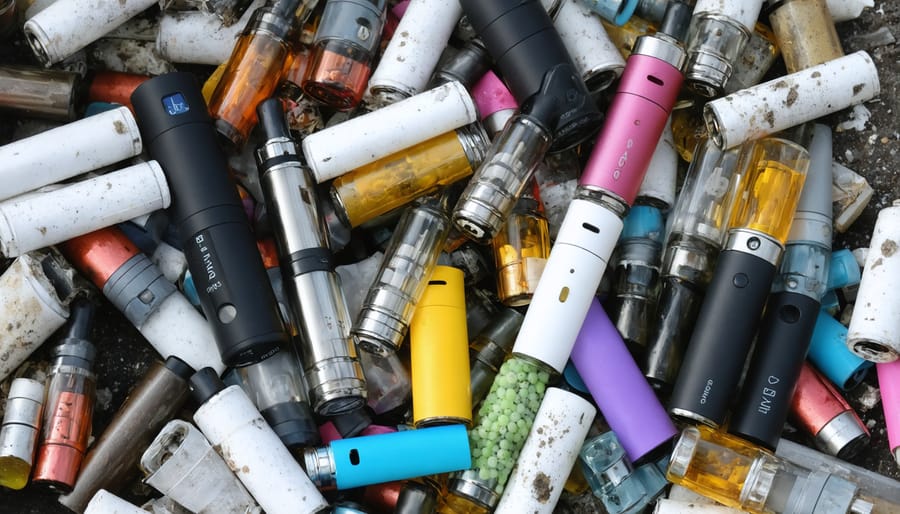As the vaping industry continues to evolve with options to discover new flavors, its environmental impact has become an increasingly important topic of discussion. This comprehensive analysis examines the ecological footprint of vaping products, from manufacturing to disposal, and explores the complex policy landscape that aims to balance innovation with environmental responsibility. Through an interdisciplinary lens, we’ll investigate how this growing industry affects our planet and what steps are being taken to create more sustainable solutions.
The Environmental Footprint of Vaping Products
Production and Waste Generation
The production of vaping devices involves a combination of raw materials and energy-intensive processes, raising significant environmental concerns. Components such as lithium-ion batteries, plastic cartridges, and metallic heating elements require extensive mining and manufacturing. These activities contribute to substantial greenhouse gas emissions and depletion of finite resources, placing a burden on ecological systems.
Moreover, the lifecycle of vaping products, from production to disposal, immensely contributes to waste generation. Disposable e-cigarettes and cartridges, often comprised of non-biodegradable materials, lead to the accumulation of electronic and plastic waste. These items frequently evade efficient waste management systems and can persist in the environment for hundreds of years. Such waste not only pollutes land and water but also poses risks to wildlife and human health due to the potential leaching of toxic substances.
The challenge of managing vaping-related waste underscores the need for a robust regulatory framework that supports sustainable practices. Policy interventions could incentivize the development of eco-friendly materials, promote the recycling of vape products, and enforce stricter disposal guidelines. These measures necessitate a collaborative approach, integrating insights from environmental science, product engineering, and policy analysis to mitigate the environmental impact of vaping.
Through interdisciplinary efforts, stakeholders can develop innovative strategies to address the dual challenge of supporting technological advancement in vaping while reducing its environmental footprint. As the vaping industry continues to evolve, aligning production processes with sustainable practices is imperative for minimizing adverse ecological effects and ensuring a balanced approach to environmental protection.
E-Waste and Toxicity Matters
Vaping devices, once heralded as an alternative to traditional smoking, have introduced new concerns related to electronic waste and toxic materials. The proliferation of these devices has led to a notable increase in e-waste, contributing to environmental degradation through improper disposal methods. This issue is amplified by the presence of batteries, heavy metals, and other hazardous materials within these devices, which, upon uncontrolled release, can lead to soil and water contamination. As seen with other forms of pollution, similar to the impact of microplastic pollution, the disposal of vaping products presents multi-faceted ecological risks.
The recycling and disposal practices currently in place are often inadequate for efficiently managing this type of waste. Many vaping products end up in landfills, where they contribute to the release of toxic substances into the environment. The lithium-ion batteries commonly used in these devices are particularly concerning due to their potential to release harmful chemicals. As they break down, they risk polluting local ecosystems and compromise public health.
Effective policy interventions are needed to address these environmental challenges, necessitating a multidisciplinary approach that includes insights from environmental science and policy experts. Developing comprehensive recycling programs, stricter regulations on product design, and raising public awareness about proper disposal methods could mitigate the adverse impacts of vaping-related e-waste. Through collaborative efforts, policymakers and stakeholders can integrate environmental considerations into the regulatory framework, ensuring that the transition to greener alternatives is not only beneficial for public health but also sustainable for our planet.

Policy Landscape and Regulatory Approaches
Global and National Policies
The global and national policies on vaping have taken varied approaches, reflecting the complexity and evolving nature of the issue. On the international stage, countries like the United Kingdom and New Zealand have adopted harm reduction strategies, viewing vaping as a less harmful alternative to smoking, thus focusing on regulations that ensure product safety and access for adult smokers. Conversely, nations such as India and Brazil, citing health concerns and a precautionary approach, have implemented more prohibitive policies, outright banning vaping products.
At the national level, the United States exemplifies a patchwork regulatory landscape, with federal efforts centered on youth prevention and nicotine content control, complemented by state-specific measures targeting flavor bans and sales logistics. Similarly, the European Union’s Tobacco Products Directive mandates stringent standards on emissions and packaging, emphasizing consumer safety and awareness.
While differences in approach are apparent, commonalities also exist, notably in the collective move towards rigorous scientific evaluation and public health considerations. Globally, there is an increasing recognition of the environmental implications of e-cigarette waste, prompting discussions on the integration of sustainable practices and the responsibility of manufacturers in end-of-life product management. As vaping industries and their environmental impacts grow, it is imperative that policy frameworks remain informed by multidisciplinary expertise, balancing public health concerns with environmental stewardship.

Challenges in Regulation
Regulating the vaping industry presents numerous challenges for policymakers who must navigate a rapidly evolving market while balancing public health and environmental concerns. As vaping products gain popularity, they introduce not only new health considerations but also environmental implications that are still being fully understood. The manufacture and disposal of vaping devices and e-liquid cartridges contribute to waste and pollution, underscoring the need for robust environmental regulations. However, creating and enforcing these regulations is complex, given the diverse range of products and materials used in the industry.
A significant hurdle in formulating effective policies is the disparity in regulatory approaches across different jurisdictions. While some regions implement stringent controls on the sale and disposal of vaping products, others lack comprehensive frameworks, leading to inconsistent enforcement and market confusion. This inconsistency complicates efforts to implement standardized environmental protections and hinders collaborative efforts that could lead to more sustainable practices.
Furthermore, as technological advancements rapidly alter the landscape of vaping products, keeping regulations up to date becomes increasingly difficult. Policymakers must work closely with scientists and industry experts to anticipate shifts and adapt policies accordingly. An interdisciplinary approach, integrating insights from environmental science, public health, and policy studies, is crucial to designing regulations that not only address the immediate implications of vaping but also consider long-term impacts on environmental sustainability.
Interdisciplinary Insights: Bridging Gaps for Effective Policy
Multidisciplinary Perspectives
The intersection of vaping and environmental policy necessitates a multidisciplinary approach to ensure comprehensive and effective regulations. From an environmental science perspective, the lifecycle of e-cigarettes must be scrutinized. The production, consumption, and disposal of vaping devices contribute to electronic waste, often bearing hazardous materials that threaten ecosystems. Analysts in this field advocate for stricter guidelines on device design to promote recyclability and extended producer responsibility.
Concurrently, energy policy experts underscore the need for sustainable practices within the vaping industry. Manufacturing processes powered by renewable energy sources can substantially reduce the carbon footprint. Policies promoting energy-efficient operations and sustainable materials are crucial considering the predicted market expansion of vaping products.
From a social sciences angle, there’s a pressing need to understand consumer behavior and public perception of vaping’s environmental impact. Studies reveal that awareness campaigns significantly influence consumer habits, making them integral to policy success. Engaging with communities to foster informed choices is thus central to bridging environmental intentions with practical outcomes.
These disciplinary insights collectively inform policymakers, offering a foundation for integrated strategies that address environmental challenges posed by vaping. A multidisciplinary framework not only addresses isolated issues but crafts a holistic and sustainable policy landscape that adapts to the complexities of modern environmental and social dynamics.

Innovative Policy Solutions
Addressing the environmental and social impacts of vaping requires innovative policy solutions grounded in interdisciplinary collaboration. The introduction of stricter regulations on e-cigarette production and disposal can greatly mitigate the environmental burden. Policies that mandate the use of recyclable and environmentally friendly materials in vaping products could encourage manufacturers to prioritize sustainability. Furthermore, a collaborative approach involving environmental scientists, social scientists, and policymakers can facilitate the development of comprehensive policies that address both the ecological impact and social dimensions of vaping.
Integration of expert perspectives is crucial. Environmental scientists can provide insights into the lifecycle and biodegradability of materials used in vaping devices, while social scientists can explore the sociocultural factors that drive vaping behaviors. This interdisciplinary exchange can inform the creation of educational campaigns aimed at reshaping consumer habits and reducing waste.
Policymakers should also leverage technology to enhance compliance and enforcement. Blockchain technology, for example, could be employed for tracking the production, sales, and disposal of vaping products, ensuring accountability across the supply chain. Engaging stakeholders from multiple sectors and continuously evaluating the socioeconomic outcomes of implemented policies can help create a dynamic framework that not only tackles the pressing environmental issues but also fosters a more sustainable vaping industry.
Future Directions and Policy Recommendations
Sustainability in Vaping
To integrate sustainability principles into the vaping industry, a multifaceted approach is essential. First, the development of eco-friendly materials for vape devices and packaging can significantly reduce environmental harm. Utilizing biodegradable or recyclable materials parallels the core tenets of sustainable living and minimizes waste in landfills. Furthermore, establishing robust take-back programs for used products encourages consumers to return devices for responsible recycling and disposal, thus reducing electronic waste. Policy interventions play a crucial role in mandating these practices, incentivizing manufacturers to innovate and adopt sustainable practices. Industry stakeholders must collaborate with policymakers and environmental scientists to set industry standards and develop comprehensive regulatory frameworks. By engaging social scientists, the industry can better understand consumer behavior and implement educational campaigns that promote sustainable consumption. This interdisciplinary effort links sustainability with regulatory compliance, providing a path that aligns environmental objectives with the realities of the market and consumer culture.
Policy Evolution and Innovation
Policy evolution and innovation in managing the environmental impacts of vaping necessitate a multidimensional approach, integrating insights from various disciplines. Given the unique challenges posed by vaping, from waste management to air quality concerns, innovative policy frameworks must be crafted with a holistic perspective. Current regulations often lag behind the technological advancements in vaping products, highlighting an urgent need for adaptive and forward-looking policies that address both existing and emerging environmental issues. By incorporating insights from environmental science, energy sustainability, and social behavior, policy-makers can effectively craft strategies that align with broader sustainability goals. For example, establishing closed-loop recycling programs, increasing public awareness, and enforcing strict production standards could mitigate the environmental footprint of vaping. By fostering collaboration among stakeholders from academia, industry, and government, innovative and comprehensive policies can be developed. This approach not only addresses the immediate environmental concerns but also sets a precedent for future regulatory practices in rapidly evolving technological landscapes.
Conclusion
In conclusion, the interplay between vaping and environmental policy demands a nuanced, interdisciplinary strategy that integrates the insights of environmental science, energy policy, and social sciences. This article underscores the pressing need to address the lifecycle impacts of vaping devices, from production through disposal, to mitigate their ecological footprint. Effective policy frameworks should leverage collaboration across sectors, balancing regulation with innovation to reduce environmental harm while considering social and economic factors. By fostering dialogue among stakeholders and policymakers, we can create comprehensive solutions that address both environmental concerns and public health imperatives. Such informed approaches are crucial for sustainable progress in managing vaping’s complex environmental and social challenges.







